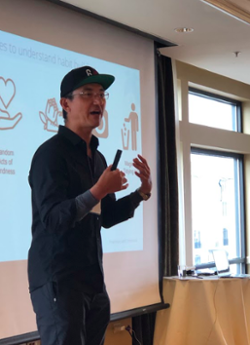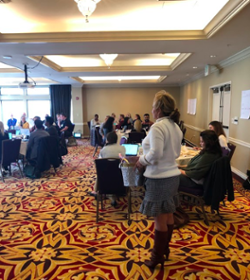|
“I was really worried about flying across the country to come here, we have a small budget for these things and this was a big expense. I am so glad I came, though. I want our whole staff to have this training.” - School Leader from NYC
Ed Elements hosted the first NSR Leadership Institute over two bright, bracing days on December 6th and 7th. 37 education leaders from across the country came to the Warwick Hotel in Denver to experience a two-day active-learning event in which the key components of developing and leading a responsive organization were named, modeled, and practiced. The institute was held in a large room on the 15th floor of the hotel, where views of the Denver skyline set the stage for thinking in terms of broad horizons.
 The Institute kicked off with a check-in, a practice from EE’s tactical meeting protocol that connects the group by allowing them to learn more about each other, and assists the facilitator in gauging the intentions and moods of the people in the meeting. School leaders were then introduced to the key components of a responsive organization and led through an exercise that illustrated the ways in which common organizational behaviors and norms can keep a group from being effective. The Institute kicked off with a check-in, a practice from EE’s tactical meeting protocol that connects the group by allowing them to learn more about each other, and assists the facilitator in gauging the intentions and moods of the people in the meeting. School leaders were then introduced to the key components of a responsive organization and led through an exercise that illustrated the ways in which common organizational behaviors and norms can keep a group from being effective.
Throughout the two days, leaders were asked to set a commitment and state a hypothesis based on the focus of the sessions they attended. On day one, they considered how to activate learning and change behaviors by focusing on being 1% better every day; they read about the importance of discussing and learning from failure, and considered how to create a team environment where it is safe to fail.
On day two, the cohort learned about practical strategies to create the change they are seeking in their schools and districts. Anthony led them through a tactical meeting protocol, and Keara modeled the TRIZ protocol (Teoriya Resheniya Izobretatelskikh Zadatch" (теория решения изобретательских задач) meaning the 'Theory of Inventive Problem Solving'), which enables teams to identify and plan for practices that will impede progress toward their goals. The afternoon sessions were devoted to managing projects, with Anthony discussing the importance of planning for change, and Keara sharing tools for effective project management.
 Energy was high over the course of the Institute, as Keara led the cohort through games and activities that illustrated and reinforced the concepts of teamwork, leadership, and learning that were outlined during the knowledge-building portions of the workshops. New friendships were formed and connections were made during the collaborative planning times, in which groups followed a protocol for discussion and feedback to help develop individual action plans. At the end of the second day, participants signed up for individual coaching with the EE Institute team, during which they shared a specific issue they wanted to address immediately, and talked through small steps they could take to nudge their teams toward consistent improvement. Energy was high over the course of the Institute, as Keara led the cohort through games and activities that illustrated and reinforced the concepts of teamwork, leadership, and learning that were outlined during the knowledge-building portions of the workshops. New friendships were formed and connections were made during the collaborative planning times, in which groups followed a protocol for discussion and feedback to help develop individual action plans. At the end of the second day, participants signed up for individual coaching with the EE Institute team, during which they shared a specific issue they wanted to address immediately, and talked through small steps they could take to nudge their teams toward consistent improvement.
The Institute closed out with a large circle share, in which participants were asked for a sound or a gesture that conveyed how they were feeling, and why they chose that sound or gesture. Sounds included fireworks, signifying popping synapses and excitement over new insights, and Keara’s gong, signifying a calm clarity and reminder to refocus; gestures included the movement of windshield wipers, which wipe away distractions and cloudiness and restore the ability to see far down the road.
Sign up here to stay informed about upcoming institutes.
|